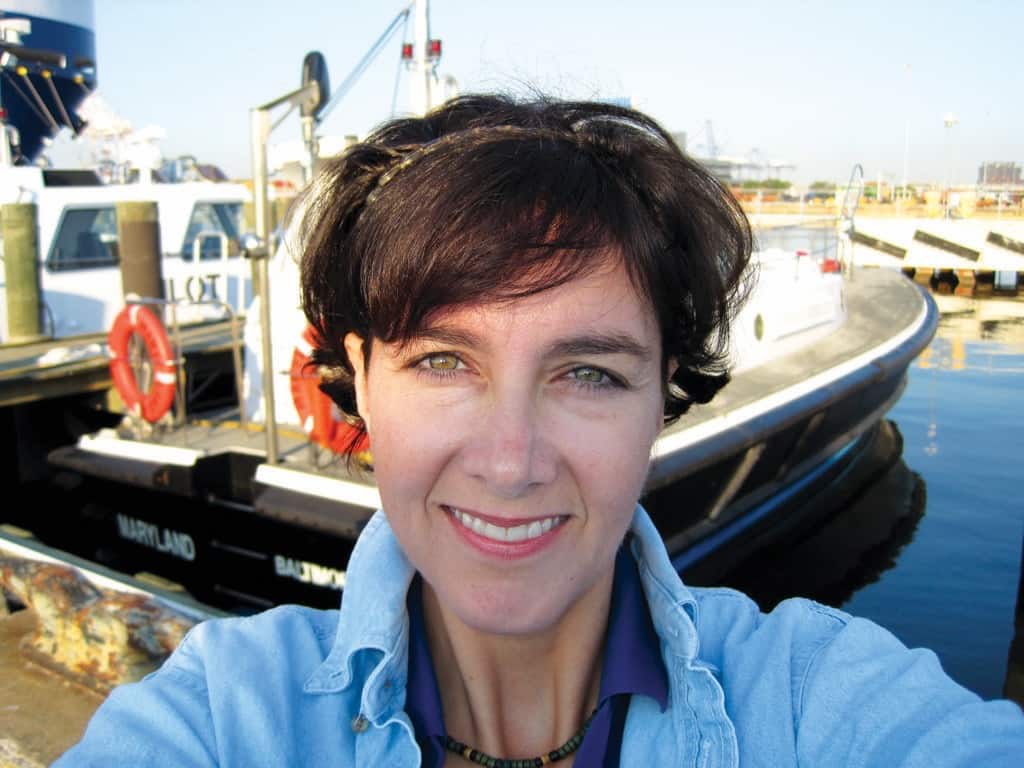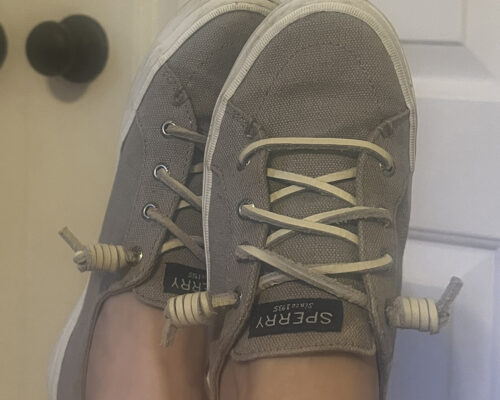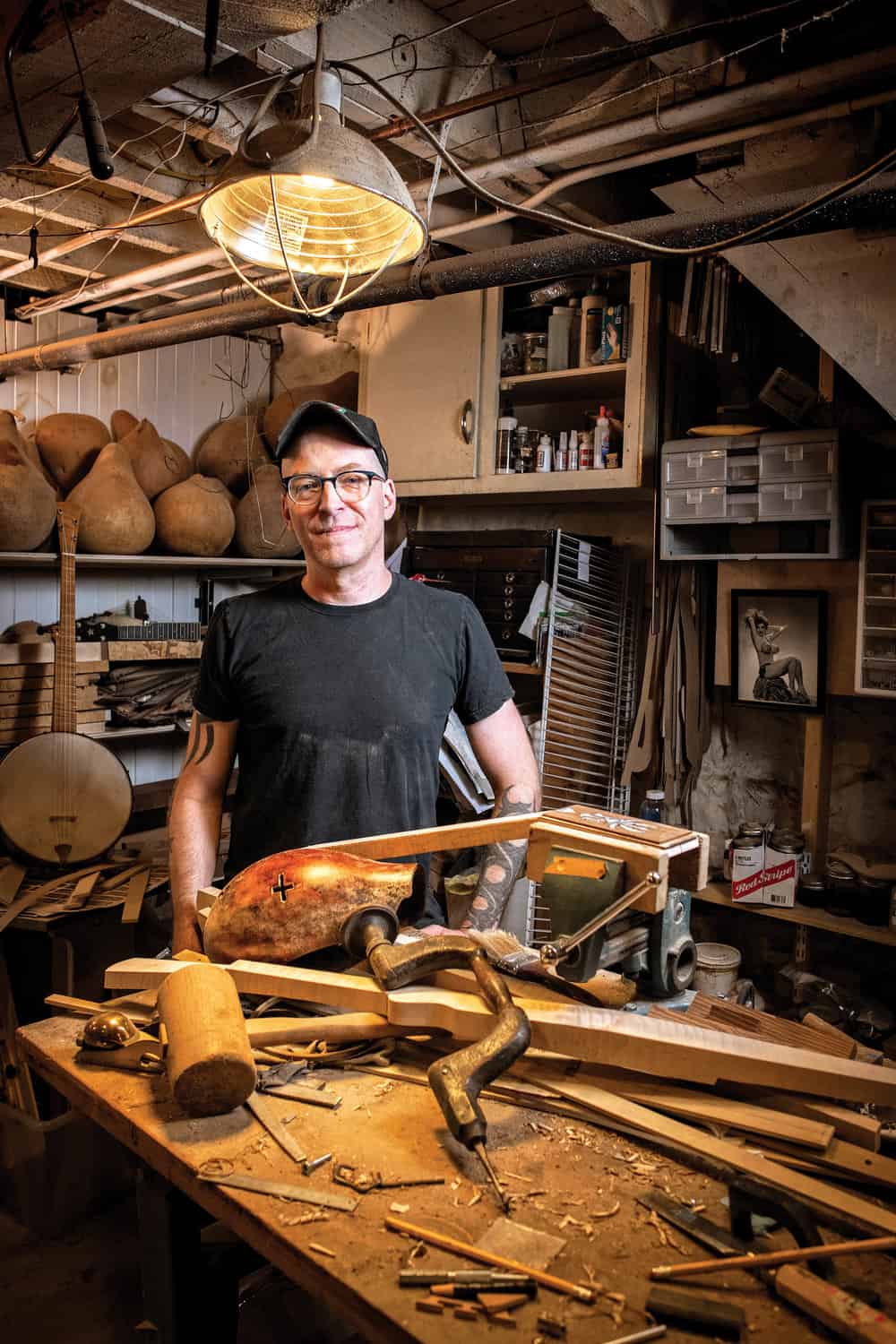Delivering Bay Pilots and roller derby hits
The ship on the other end of Christine Cleary’s binoculars could not be more different from the one upon which she earned her sea legs three decades ago as a newly graduated college student hankering for adventure.
The ship is the Thamesborg—a 14,695-ton freighter flagged in the Netherlands—and it had just unloaded a cargo of aluminum at Sparrows Point. It is being nudged from the dock by the tug April Moran on a mild and beautiful morning in the last week of 2019.
Cleary, 50, is at the wheel of the 43-foot launch Maryland, owned by the Association of Maryland Pilots. She idles the boat’s twin 300 horsepower engines nearby, waiting for the tug to shove off when the ship enters the channel near Fort Carroll.
The April Moran peels away, the cue for Cleary to perform a bit of water ballet somewhat more graceful than the hard-knocks she employs as “Chris Crafty,” a skater for the Hampden Hons roller derby team. (“I’m not cool, but I like myself,” she said later with a chuckle.)
Pulling alongside the 564-foot moving freighter, Cleary steadies the boat as the apprentice who guided the Thamesborg into the channel clambers down a rope-and-wooden ladder. Once on board, Cleary will ferry him to a waiting car at the Dundalk Marine Terminal, a routine she fulfills in shifts, seven days on/seven days off, year round, for the 70 or so pilots (predominantly men but also a few women) who shepherd ships in and out of the Chesapeake Bay.
The apprentice is Kyle Hudgins, a third-generation mariner and son of a tug captain. The Thamesborg is his last job of the day after handling three ships. He greets Cleary warmly, says that seafarers from around the world look forward to her smile when the launch comes alongside, and, most importantly, that he and his colleagues feel safe when she is on the job.
“We put our lives in her hands every time we go up and down that ladder,” said Hudgins, 31, at the end of his two-year apprenticeship. “You don’t want to have to think about it.”

On a day like December 28th of last year—the harbor was “flat-ass calm,” she said, virtually no wind with temperatures in the mid-50s—Cleary’s job was a lollipop. But that day was something of a winter’s gift, a singular morning of out of 365 in the famously fickle weather of the Chesapeake Bay.
“You have to safely put that boat alongside the ship when the ship is moving, something [laymen] tend to forget,” said Gregory Lukowski, a former tug captain and retired Bay pilot whose family has worked the Baltimore waterfront since the early 20th century. “You’ll have days when the spray turns to ice as soon as it hits the boat with 40-knot winds with two-to-three-foot seas, just shy of a gale.” (Thus the Maryland’s heated handrails, which run off of the Cummins diesel engines.)
”Sometimes you’ll climb that ladder with a white knuckle grip,” said Lukowski, one of the few pilots who has seen Cleary work the bump-and-bruise of a roller derby queen. “But that was never the case when Christine was driving the launch.”
Cleary lives in the Morrell Park neighborhood of southwest Baltimore with her husband, Brad Fleury, a cabinetmaker she met through his work on the U.S.S. Constellation and their shared affection for wooden ships.
Born in Boston the year the Beatles broke up, Cleary is the daughter of a sheet metal worker named Paul and the former Eleanor Nichols, a homemaker who returned to college and became an administrative assistant at Tufts.
“The theme here is leaving home,” she said. “My parents tried to persuade me to stay close to home, and I always wanted adventure.”
With the Maryland Pilots since 2003, Cleary holds a 100-ton “near coastal” master’s license from the Coast Guard and previously ran a Baltimore water taxi, docking and undocking all day, answering questions from tourists and telling kids to stop running.
Her journey from SUNY Stonybrook, where she played Division I soccer, to respected sea dog began in 1993 when she heard a public service announcement on the radio.
The 125-foot, double-masted schooner Spirit of Massachusetts—then an educational vessel and now a floating restaurant in Kennebunk, Maine—was looking for volunteers. With only a degree in political science on her resume, Cleary was accepted. She stood watch on a six-day trip to the Pine Tree State (for which she paid a fee) before signing on for the rest of the summer.
Then came the Lene Marie, a ketch-rigged tall ship built in 1910 before foundering in a Baltic Sea storm during World War II. Said to be haunted, the ship was raised by the U.S. military only to sink for good in 1996. By now, Cleary had found her life’s work, signing onto tall ships between Maine and the Caribbean as the seasons dictated, each gig about a four-to-six-month contract.
In the spring of 1999, the sea brought her to Crabtown and the Pride of Baltimore II to help rig the clipper for a tour of the Great Lakes while working on deck and as an assistant engineer. Cleary sailed the Pride for the next five years, working her way to chief mate for voyages
that included a trip from Norway to Baltimore by way of the Canary Islands, before going to work for
the Pilots.
“I miss sailing with a capital S—it’s like a religion,” she said. “But the nomadic nature of working on schooners is an intense existence. You live and work in this 100-foot boat with anywhere from a dozen to 30 people with no personal space except your bunk and the head.”
After a half-year of that, she said, no matter how alluring the adventure, “you’re done.”
And, by about noon on December 28—the pilot on his way back to the office, the Thamesborg well beyond the Key Bridge—Cleary was done for the day.
As she steered the Maryland toward a bulkhead at Canton Waterfront Park, a black crow settled on the bow railing, sitting in the breeze as the launch moved through the dark brown water of a “mahogany tide” algae bloom.
In her time working the harbor, Cleary has found a dead manatee wedged beneath a pier and now and then scoops turtles from the shallows of Colgate Creek to give them healthier homes. Seagulls will do anything they please and, while the boat is tied up, crows often perch on the railings.
But a black bird worthy of Poe alighting in the headwind like a living figurehead?
“Never seen that before,” she said.




